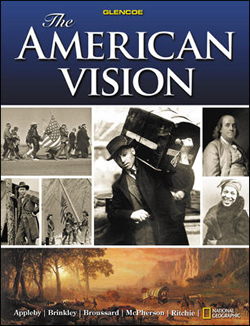
The American Vision © 2008Chapter 25: The Civil Rights MovementChapter OverviewsThis chapter traces the civil rights movement of the 1950s and 1960s, from the time when African Americans first began to fight against segregation in the South to the nationwide battle for economic equality. Section 1 discusses the beginnings of the civil rights movement. In the first half of the 1900s, African Americans and the NAACP began to use political power to challenge segregation and demand more rights. After World War II, protests against segregation grew more determined, and the civil rights movement emerged. In 1954 the Supreme Court ruling in Brown v. Board of Education struck down segregation in public schools. Many white Southerners vowed to resist the decision, but many African Americans became convinced that the time had come to challenge other forms of segregation. In Montgomery, Alabama, Rosa Parks inspired a bus boycott when she refused to give up her seat on a crowded city bus. The success of the bus boycott made Dr. Martin Luther King, Jr., a leader of the national civil rights movement and inspired the founding of the Southern Christian Leadership Conference. While President Eisenhower preferred a gradual end of segregation, he used military forces to protect African American students and showed his support of African American voting rights with the passage of the Civil Rights Act of 1957. Section 2 describes how the civil rights movement gained momentum. During the late 1950s and early 1960s, African Americans and white supporters formed organizations to fight segregation and give Southern African Americans a political voice. Activists used nonviolent tactics—sit-ins, voter registration drives, freedom rides, protest demonstrations, and marches—to garner national attention for the civil rights movement. As television cameras captured violent images of attacks on civil rights demonstrators, a wavering President Kennedy decided to throw his support behind the struggle for civil rights. The Civil Rights Act of 1964 outlawed discrimination based on race, gender, religion, or national origin and gave equal access to public facilities. Another monumental civil rights law, the Voting Rights Act of 1965, protected African Americans' voting rights. Section 3 explains how the mid-1960s saw the civil rights movement shift its focus to economic equality for African Americans. By 1965 the civil rights movement had achieved the passage of several civil rights laws, but African Americans across the nation still faced prejudice, discrimination, and economic inequalities. Hope gave way to frustration and anger when civil rights laws failed to change the everyday hardships of African Americans. Race riots broke out in dozens of American cities between 1965 and 1968 as some became impatient in the struggle for civil rights. Frustration with nonviolent protests led some African American leaders to advocate black power, black pride, and black nationalism, and some African Americans called for violent action to end racial oppression. In 1968 an assassin's bullet took the life of Dr. Martin Luther King and ended an era of unified and visionary civil rights achievements that had transformed American society. |  |















